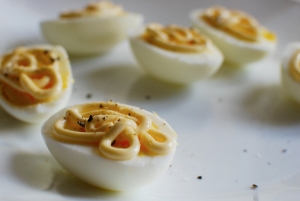Mayonnaise is one of the most popular sauces in the world, served with almost any kind of dish from fast food to fancy restaurant dishes. It serves as a base for countless sauces and is one of the top-selling products in supermarkets around the globe. But, what is mayonnaise? Can I make it at home? These are some of the questions that people often ask about mayo and we will try to give you the best answers we can.
The first mentions of mayonnaise come from the 19th century when cooks in Europe started making a sauce similar to modern-day mayonnaise, except it was based on gelatin instead of eggs. With time the sauce became more and more like the modern mayo and the product grew into the most used sauce out there. Mayonnaise is a fairly simple creamy cause, made of a mixture of egg yolks, oil, and either vinegar or lemon juice. While there are many alternative recipes that can be used this is the basic recipe for mayonnaise and additional spices, flavors, and ingredients added will simply change the flavor of the sauce or make it different in nutritional ways.
So What Is Mayonnaise?
Mayonnaise is very easy to prepare as well and it can be prepared in any kitchen with minimum effort. Simply add oil slowly to egg yolks while whisking the mix in the bowl with a fork or whisk. You can also add a bit of mustard or spices to improve the flavor and vinegar or lemon juice for the base flavor should be added.

Mayonnaise Nutrition Facts
Most commercial mayonnaise products consist of about 80% vegetable oil, 7% water, 6% egg yolks, and small percentages of vinegar, salt, and sugar. Some formulas use entire eggs instead of just the yolks while some use lemon juice instead of vinegar.
Mayonnaise is extremely high in calories, containing about 700 kCal per 100 grams of the product. This is why the sauce is absolute to be taken in moderation. The majority of the calories in mayonnaise will come from fats as 100 grams of mayo contains 75 grams of fats, including monounsaturated, polyunsaturated, and saturated fats. The product contains minuscule amounts of protein and carbohydrates, as well as some low amounts of vitamins and minerals. 100 grams of mayo will, however, give you 25% of your recommended daily sodium intake, but to be perfectly honest, 100 grams of mayo is too much for one day.
Mayonnaise Benefits
Now, while I did say in the last paragraph that mayonnaise contains a lot of fats, and fats usually ring alarm bells in our minds, the majority of the fats you will find in mayonnaise are unsaturated fats. The unsaturated fats are often referred to as “good fats” as they come from plant sources as opposed to animal sources and they are not necessarily bad for you.
The fats in mayonnaise actually have their upsides. When you eat vitamin-rich foods you get vitamins in your system, but in order for these vitamins to become bioavailable, they need fats as they are fat-soluble. Eating some mayonnaise will allow for your vitamins A, D, E, and K to become more bioavailable and will actually help you improve your overall health. Additionally, mayonnaise itself can be a great source of vitamin E which can help prevent strokes and other heart issues.
Other uses of mayonnaise with positive impacts include rubbing it on your skin to make it softer or heal sunburns or using it to strengthen your hair. Some studies have also shown that eating mayonnaise can be good for your lungs.
Mayonnaise Cons
When it comes to mayo, there aren’t a whole ton of cons. The product is delicious and as we stated it can actually be good for your health. The main downside is the calorie count. Eating a mere 300 grams per day would give you more calories than most adults should be taking in their whole daily diet. Now, obviously, you will not eat 300 grams per day, but even 50 grams will contain 350 calories, an equivalent of 3-4 bananas or 200 grams of chicken breast.
While mayonnaise as a dietary addition can be great, people often tend to overdo stuff, and overdoing mayonnaise will simply make you straight-up fat. In order to protect yourself from the negative sides of mayo simply take it in moderation and you will actually gain much more than you will lose.
Mayonnaise-Based Sauces
This is where mayonnaise becomes fun. A whole ton of sauces that are served with meals in restaurants around the world are actually based on mayonnaise. Some examples of such sauces include Tartar Sauce, Buttermilk Ranch Dressing, Remoulade Sauce, Tahini Mint Sauce, and a whole bunch of others.
Mayonnaise is one of the basic foods found in every cook’s kitchen and it would be hard to imagine modern-day cuisine without mayo. Adding spices and ingredients to mayonnaise will give you some interesting sauces, and there is absolutely nothing wrong with experimenting either. Try adding your favorite flavors to mayo and see what happens. If it doesn’t taste well, you can find hundreds of mayo-based sauce recipes online and in different cookbooks. Enjoy your mayo in moderation.

Conclusion
An integral part of modern-day cuisine around the world, mayonnaise has become one of the most important additions to meals. It seems that whatever cuisine you want to try you will get either pure mayo or some sort of mayo-based sauce to go with your meals.
Mayo can be good for you in moderate amounts as it was proven to help with heart and lung health, as well as some other issues. Still, make sure you eat moderate amounts, as the super high calorie and fats count is not something you want to spend hundreds of hours burning off at the gym.
Image Credits
Images used via the creative commons license – https://creativecommons.org/licenses/by/2.0/
Image One by Juels – https://www.flickr.com/photos/stone-soup/4795862818/
Image Two by Juels – https://www.flickr.com/photos/stone-soup/7534338696/
Image Three by Janie – https://www.flickr.com/photos/geishabot/4261297914/